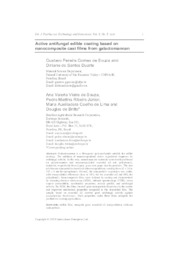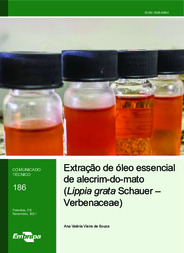Lippia grata essential oil can control fungi and bacteria in crops
Lippia grata essential oil can control fungi and bacteria in crops
Photo: Clarice Rocha
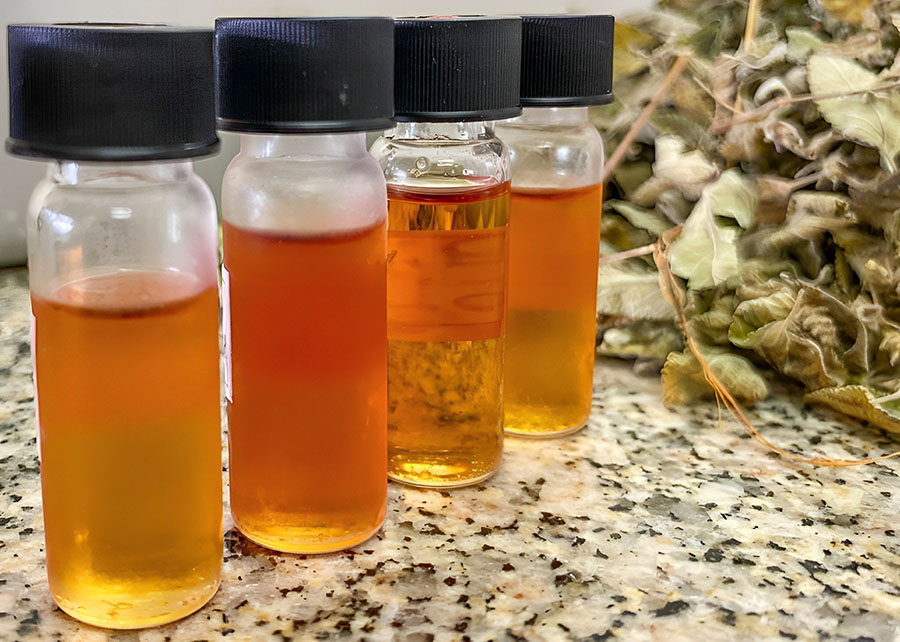
Analyses have demonstrated the effectiveness of Lippia grata essential oil to control disease-causing fungi and bacteria in several crops
|
Studies led by Embrapa Semi-Arid Region indicate that the essential oil extracted from Lippia grata Schauer Verbenaceae – a native species of the Caatinga biome locally known as alecrim do mato (wild rosemary) or alecrim da chapada – has a vast commercial potential for the production of biological pesticides. The studies have shown high levels of thymol and carvacrol in its leaves, compounds that have recognized strong antimicrobial action against several microorganisms of agricultural importance.
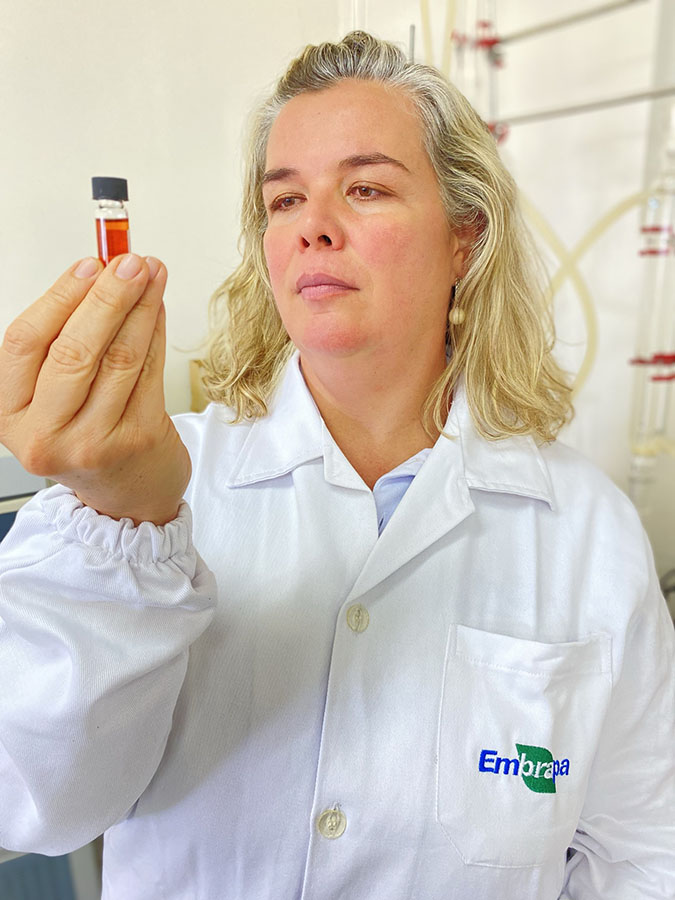 "The analyzes by Embrapa and partners demonstrated the effectiveness of Lippia grata essential oil to control fungi and bacteria that cause diseases in several crops", explains researcher Ana Valéria Vieira de Souza (pictured on the right), who coordinates the studies to domesticate the plant and enable its commercial exploitation. The microorganisms that can be controlled includeColletotrichum gloeosporioides, C. musae, C. fructicola, C. asianum, Alternaria alternata, A. brassicicola, Fusarium solani, F. oxysporum f. sp. Cubense, Lasiodiplodia theobromae, Thielaviopsis paradoxa, among others.
"The analyzes by Embrapa and partners demonstrated the effectiveness of Lippia grata essential oil to control fungi and bacteria that cause diseases in several crops", explains researcher Ana Valéria Vieira de Souza (pictured on the right), who coordinates the studies to domesticate the plant and enable its commercial exploitation. The microorganisms that can be controlled includeColletotrichum gloeosporioides, C. musae, C. fructicola, C. asianum, Alternaria alternata, A. brassicicola, Fusarium solani, F. oxysporum f. sp. Cubense, Lasiodiplodia theobromae, Thielaviopsis paradoxa, among others.
In addition to its agricultural potential, the oil also holds promise for use in animal and human health. "In animal farming, for instance, studies have shown its effectiveness in the treatment of mastitis, a disease with a relevant impact on animal production that is is caused by the bacteria Staphylococcus sp”, Souza says.
The essential oil's antiseptic, antifungal, antibacterial and anti-inflammatory properties have also been observed against microorganisms like Pseudomonas sp., Candida albicans, Bacillus cereus and Escherichia spp. The promising results can create new possibilities for the use of the plant in the pharmaceutical industry.
Become one of Embrapa's partnersEmbrapa Semi-arid Region is looking for partnerships to expand or advance the development of studies on Lippia grata. There are promising results that point to the large potential of the essential oil from the species for the development of biopesticides and phytopharmaceuticals. Those interested in learning more about Embrapa's research results can contact the center's Technology Transfer team by email cpatsa.chtt@embrapa.br. |
Application in mango farming
At Embrapa there are ongoing studies on the use of Lippia grata essential oil in the post-harvest of mangoes, fruits of great socioeconomic importance for Brazil. According to researcher Douglas de Britto, the goal is to explore the antifungal properties of Lippia grata oil by applying it to a coating to maintain fruit quality and extend its shelf life.
To that end, Britto explains that the oil needs to be encapsulated in nanoparticles due to its high volatility, that is, the easiness with which the substance changes from liquid to its gas state. "We have to use nanoencapsulation techniques so that it is more attached, more fixed to such coating, and can really be effective for our purposes," he reports.
According to the researcher, they held not only in vitro tests to control microorganisms but also in vivo assessments, wherein the coating was applied onto the mangoes and, in a cold chamber, the evolution of plant physiology, ripening speed and incidence of fungi were monitored.
The work integrates Embrapa's efforts to identify assets that prolong fruits' post-harvest life using biodegradable coatings that are safe for humans and the environment.
Essential oilsAccording to the International Organization for Standardization (ISO), essential oils are products obtained from a natural raw material of plant origin, either by steam distillation, by mechanical processes like crushing citrus peels, or by dry distillation They are complex compositions of volatile substances that are liquid, either colorless or slightly yellowish, and recognized for their characteristic aroma and flavor. These oils offer a wide range of applications in the chemical, pharmaceutical, aroma and fragrance industries, as well as the food industry. |
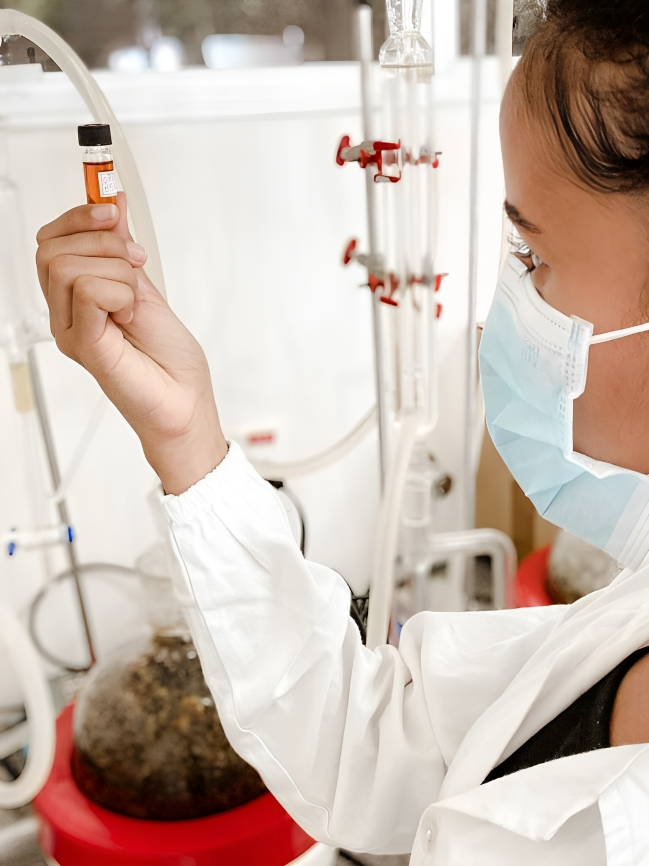 “We have several types of chemical compounds that are used to control fungi, but these products can often lead to microbial resistance. When we use a natural product, such as the Lippia grata essential oil, we have something more effective, which can be safely ingested by humans and which also contributes to reducing the emergence of resistant strains," Britto asserts.
“We have several types of chemical compounds that are used to control fungi, but these products can often lead to microbial resistance. When we use a natural product, such as the Lippia grata essential oil, we have something more effective, which can be safely ingested by humans and which also contributes to reducing the emergence of resistant strains," Britto asserts.
Formulas and strategies to enhance the effectiveness of the oil in the post-harvest stage are being perfected. "The studies are in the laboratory stage and the next step will be the assessment of the coating in mango processing facilities on a pilot scale," the scientist states, as he informed that, in addition to mangoes, the researchers intend to test Lippia oil on other fruits of commercial interest, such as grapes.
He also highlights the importance of the Caatinga biome as a source of new molecules of commercial interest. “The Caatinga has a rich and yet underexplored biodiversity. We hope that this work can also broaden awareness of the vast bioeconomic potential of the biome," he concludes.
NanocapsulationNanocapsulated ingredients comprise tiny particles on a nanoscale, which enclose and protect active principles, substances or compounds within capsules that have dimensions that are so small that are measured on the order of nanometers (one billionth of a meter). The nanocapsulation technique is used to enhance the stability, protection, and efficacy of certain substances, such as drugs, nutrients, fragrances, essential oils, and others. It allows the controlled and targeted release of the compounds, which not only improves their absorption and potency but also makes them last longer. Such technique is used in a wide range of fields, including medicine, cosmetology, and agriculture. |
Clarice Rocha (MTb 4.733/PE)
Embrapa Semi-Arid Region
Press inquiries
semiarido.imprensa@embrapa.br
Phone number: +55 87 3666-3734
Translation: Mariana Medeiros (13044/DF)
Superintendency of Communications
Further information on the topic
Citizen Attention Service (SAC)
www.embrapa.br/contact-us/sac/


